-
Posts
411 -
Joined
-
Last visited
Posts posted by kensal
-
-
@Cpl Carrot, question for you. It has been mentioned and I read it again in the Master Maps announcement that there are some improvements included that make urban fighting better. Is it your goal to show off some of these improvements?
Ha ha, actually you want to know what they are now!
-
Peachy
Very peachy
-
Turn 22 completed
oo-er I've exceeded my bandwidth allowance. Clearly I've got too carried away with my screenshots. Apparently my allowance will be reset in a few days so I will post some more (but not so many this time) screenshots then.
In the meantime, D Company took 1 casualty this turn but shot down four more of the defenders retreating into central Buron from the trench and Green House. A Coy and the Stuarts have nearly linked up south of Buron, to complete the encirclement.
-
Thank you very much for your replies - very kind
-
I have a Market Garden question:
Should the operation have taken place at all?
I think not. I still cannot understand the strategic thinking behind it. Irrespective of all of the operational issues such as the location of II SS Pzkorps, pushing two divisions down a single road, even if it had been a success, with Gds Armoured and 43rd Division over the bridge at Arnhem, we would still have been left with an outcome which depended on a significant amount of work to widen and expand what would effectively have been a small beachhead over the Rhine and which remained dependent on a ludicrously narrow channel for supply and which would have been instantly and violently attacked by as many reserve forces the Germans could muster a la Anzio. The concentration of British forces in the beachhead would have been a dream target for heavy German artillery assets and the experience of the war to date was that the Germans were masters at quickly mobilising forces to prevent quick exploitation.
Could we have put any further motorised or armoured divisions up the road to exploit the breach and supplied them as well down the same road?
It seems to me that at best the beachhead would have remained a beachhead until the areas to the north east of Arnhem, like the Scheldt estuary area and front line to the south east had caught up, all of which meant significant fighting through difficult terrain in worsening autumnal weather.
A successful operation might have prevented the Germans launching their Ardennes attack as they committed reserves to attacking the beachhead or defending its exploitation, but arguably that might have prolonged the war, if one subscribes to the view that the failure of the Ardennes offensive robbed the Germans of any chance of delaying the Allied advance into Germany in early 1945.
I find it difficult to see how the successful outcome of the operation to take Arnhem bridge would have resulted in the planned fanning out of 21st Army Group on to the North German plain in late 1944.
-
JonS
I am creating a scenario at present and I want to represent an area that has already been fought over. There would be several already destroyed tanks / vehicles and I want to ad these as flavour objects. I have seen destroyed vehicles in other scenarios but I have not been able to find out how to add them.
Do you know how to do this?
Many thanks
Kensal
-
2nd Squad's teams have been slowing down his infantry as they advance on the town, so Ken fired with I think two of his Centaur AA tanks... click this link to see video of Ken's Centaur AA tank firing on A Team
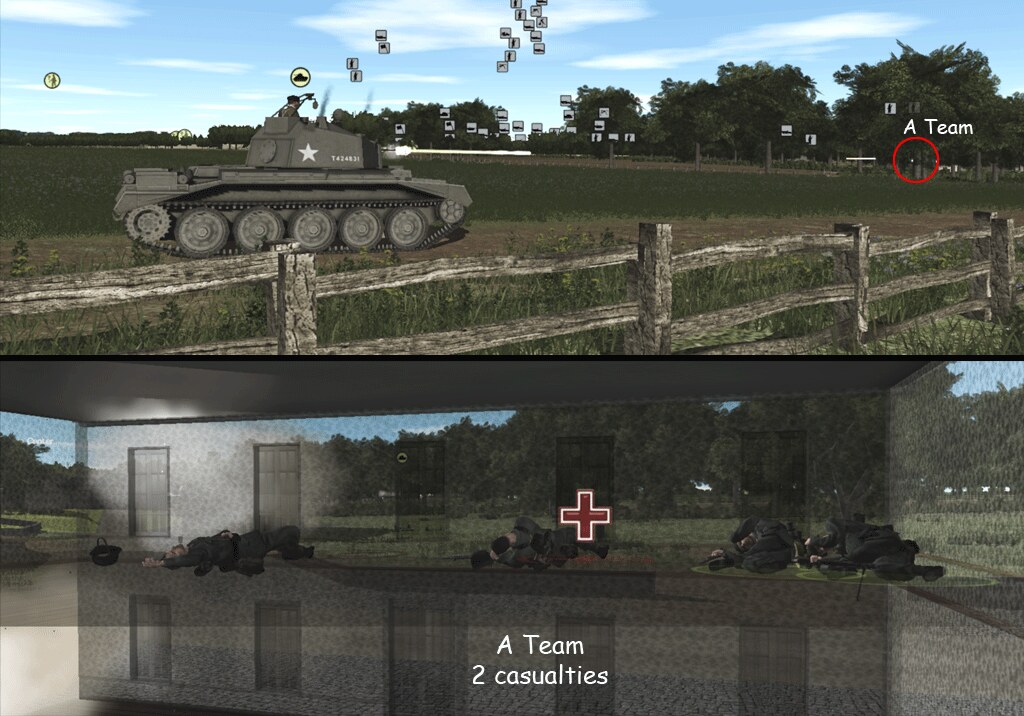
I want one. I want NOW!
-
Turn 22 completed
Mortar fire hits another suspected German position in the centre of Buron
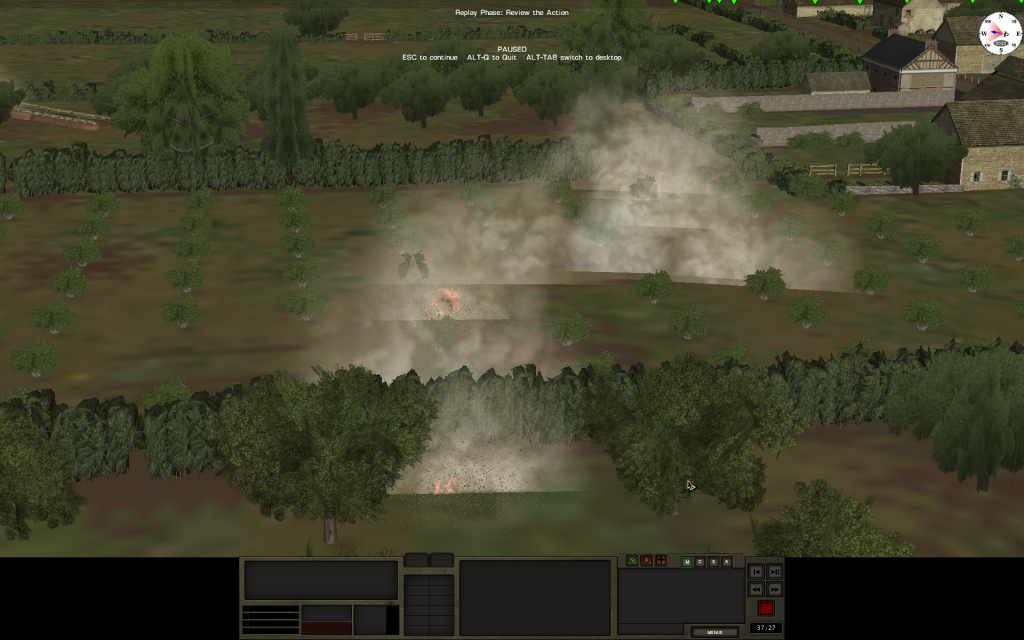
Some situation maps:
D Coy highlighted. It will continue moving west
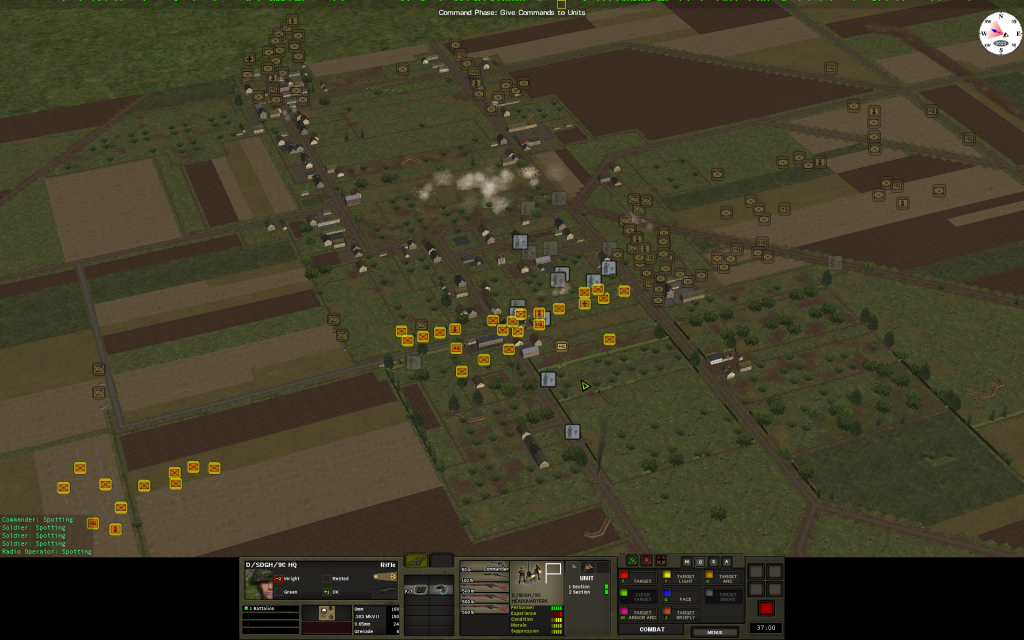
C Coy highlighted. It will support D Coy and move down the east-west parallel road to get in position to assault central Buron.
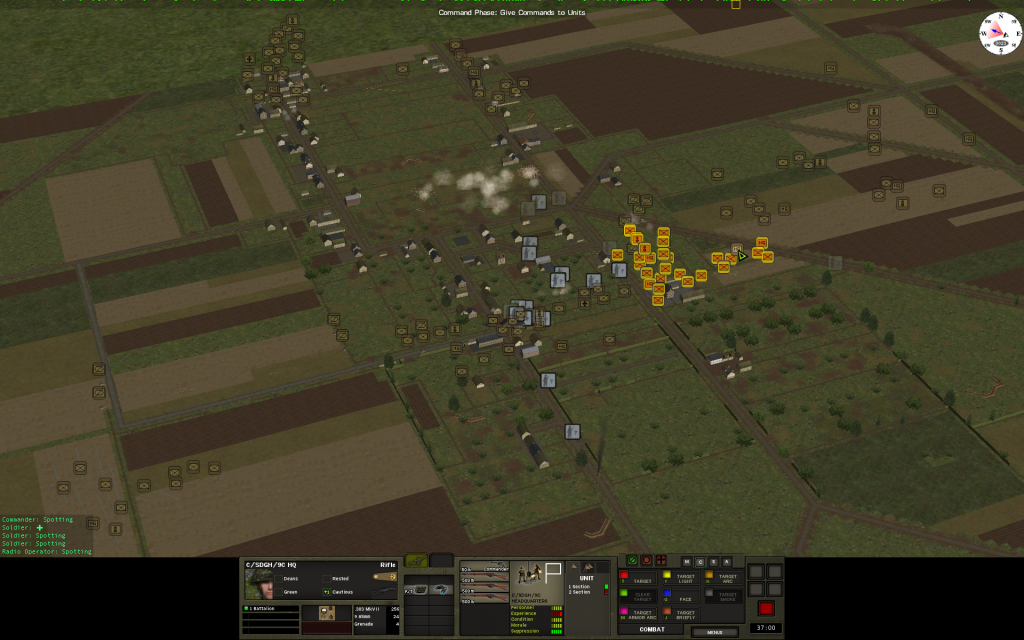
B Coy highlighted. In reserve. I don't think it will be necessary to involve it further, save in providing long range suppressive fire on suspected enemy positions. At this stage I am mindful that there is likely to be a counterattack by 25 SS PzGr Regt with tanks in following CM battles.
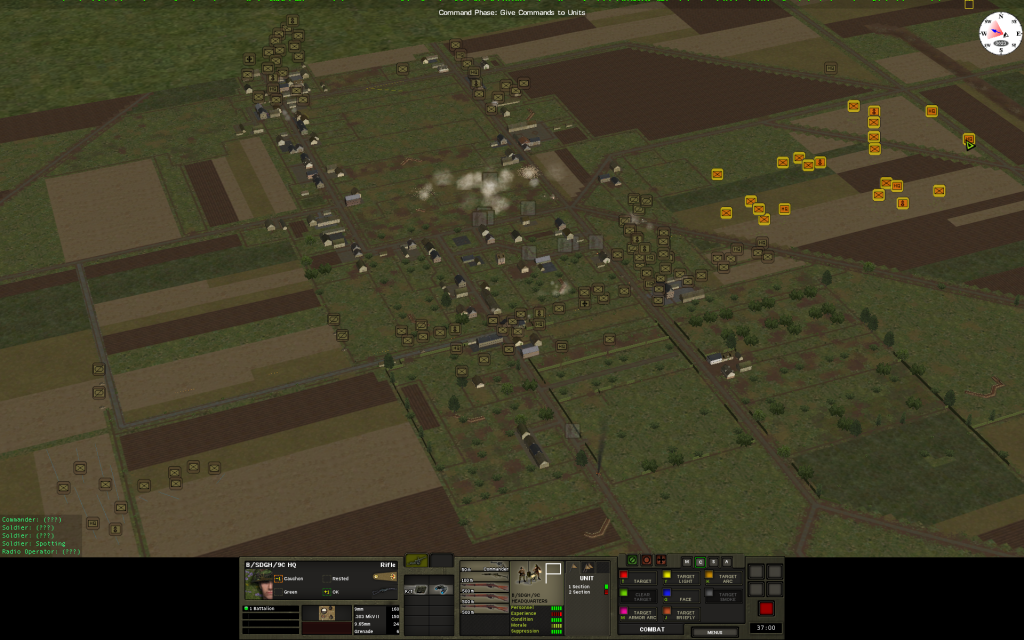
A Coy highlighted. It is facing no opposition at present and has control of west Buron. One platoon will head south east out of west Buron to cover any escape routes and eventually to link up with 8 Platoon, D Coy, which is the furthest south D Coy unit
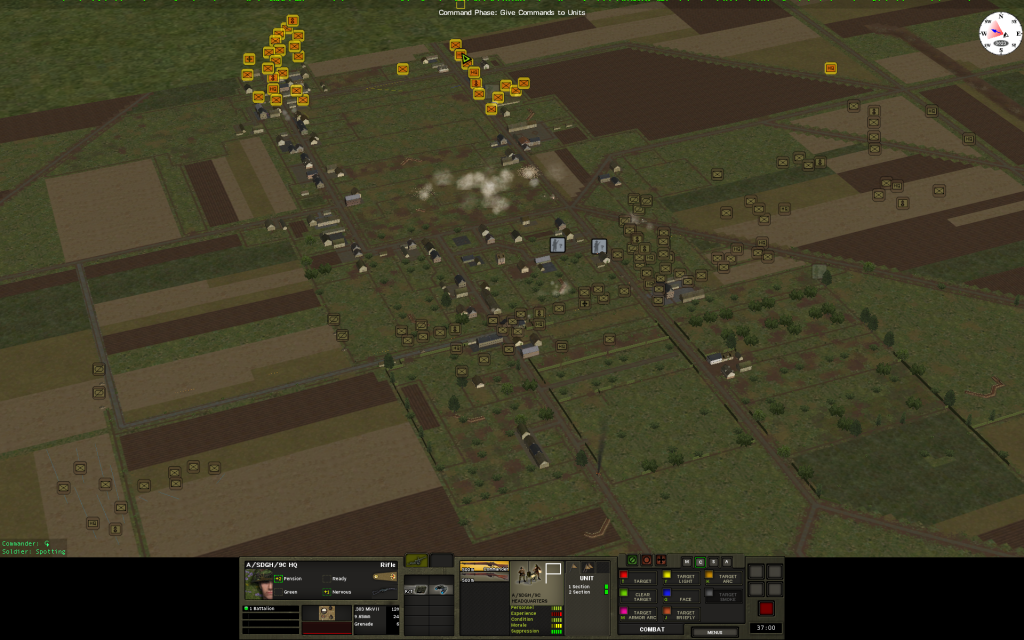
-
turn 22 completed
And suffer 2 further casualties

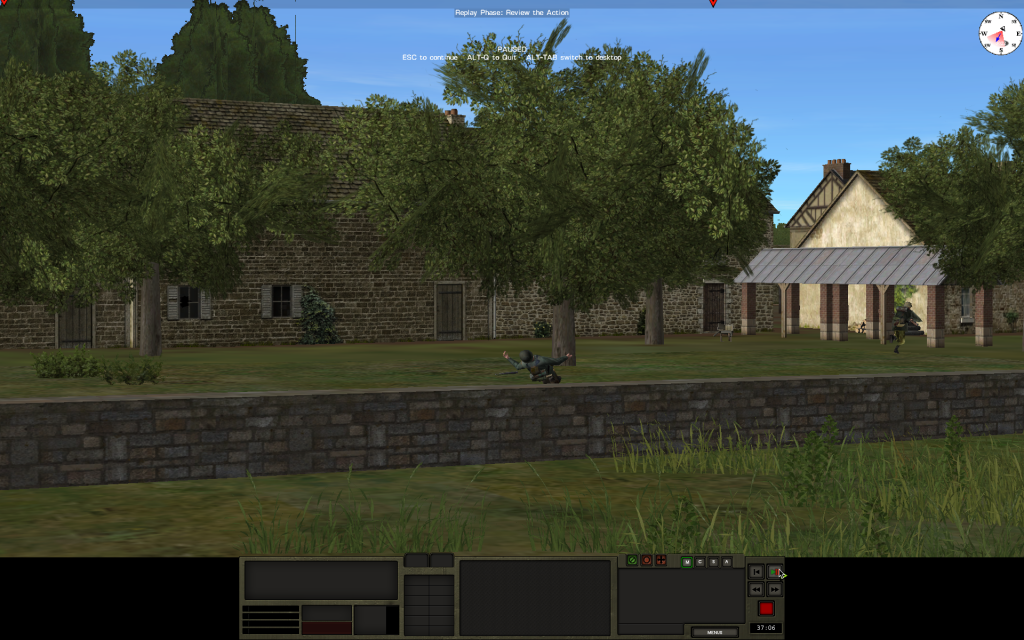
-
Turn 22 completed
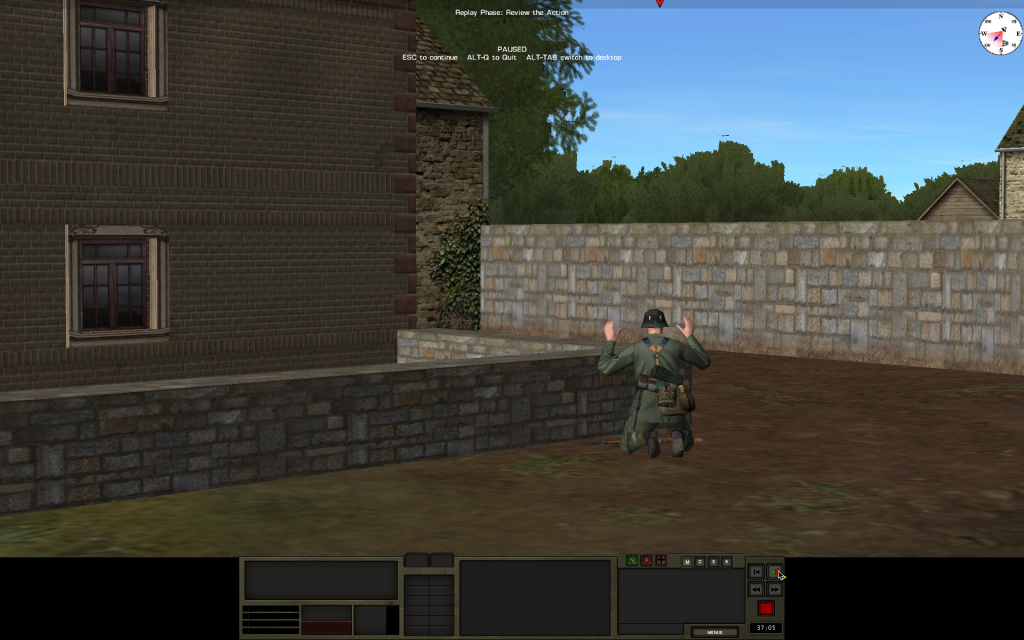
The remaining 6 or 7 make their escape through the gardens to the west, running through fire from 10 Platoon
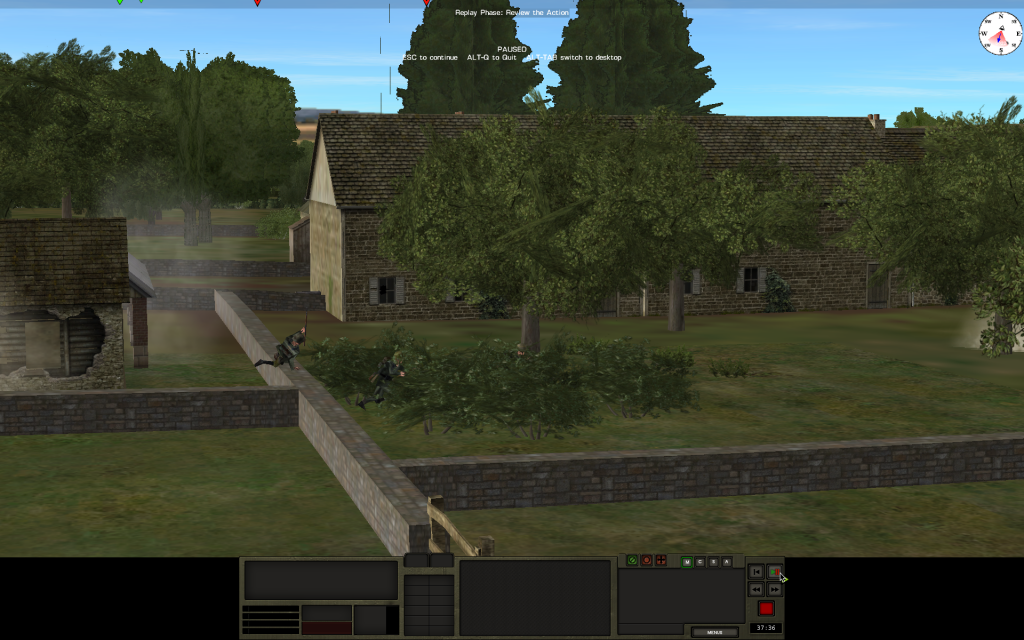
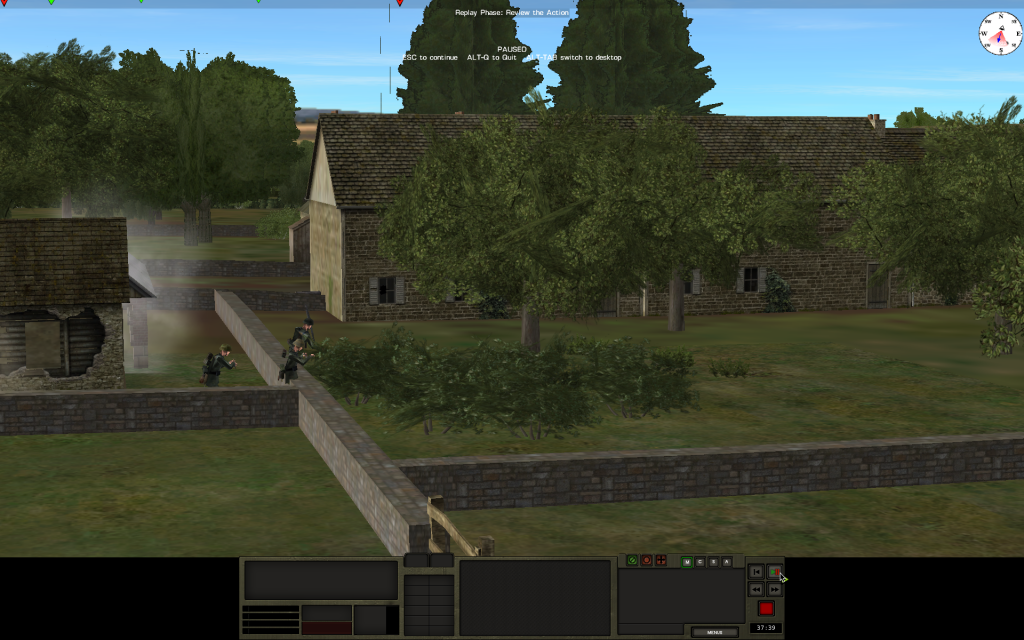
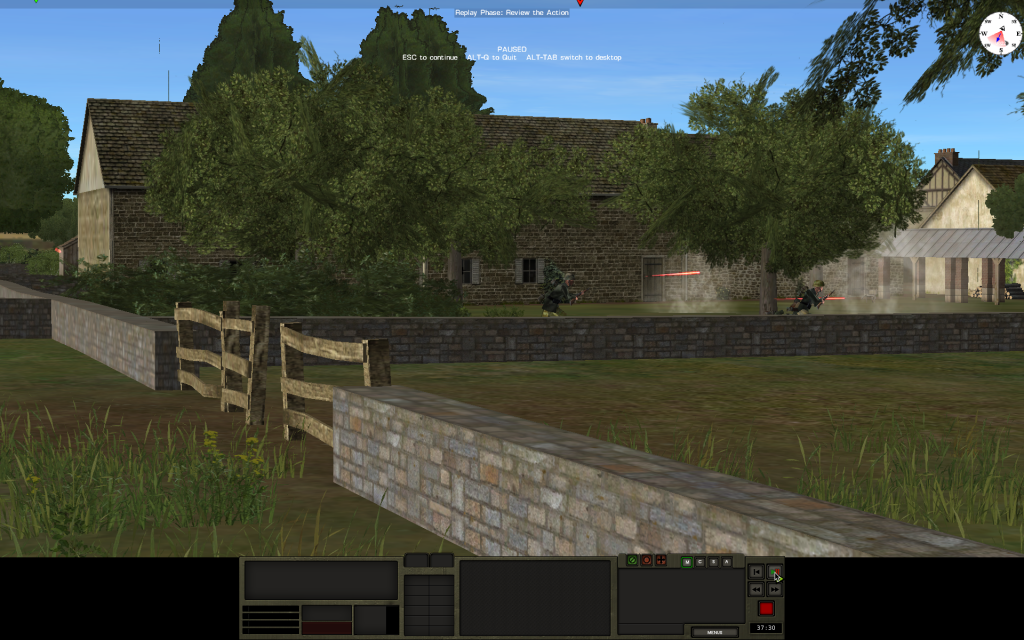
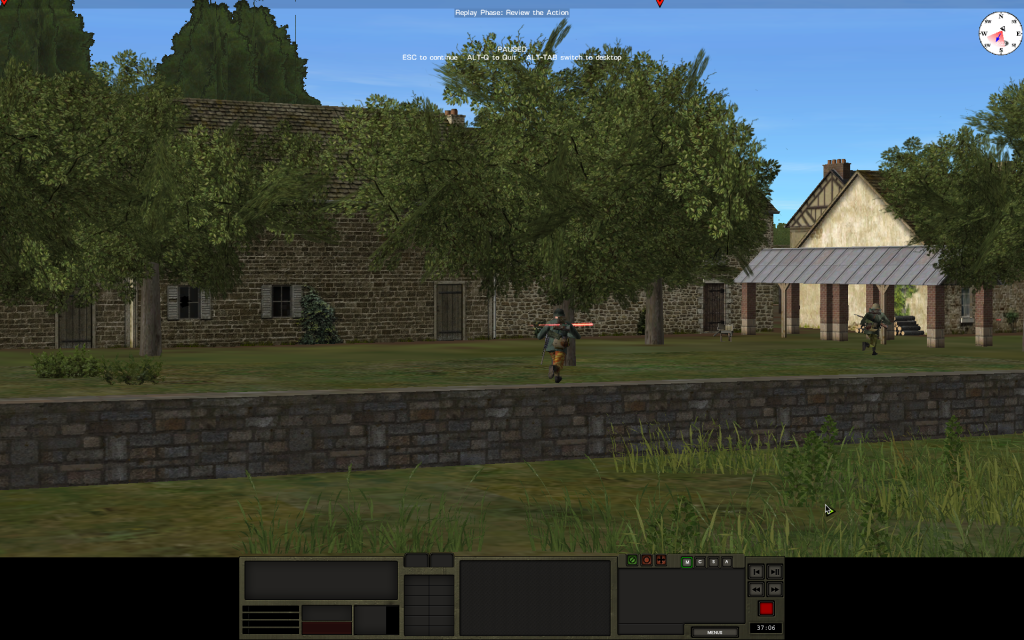
-
Turn 22 completed.
10 Platoon, D Coy gets its revenge:
The Germans in the green house are subjected to fire from several different angles
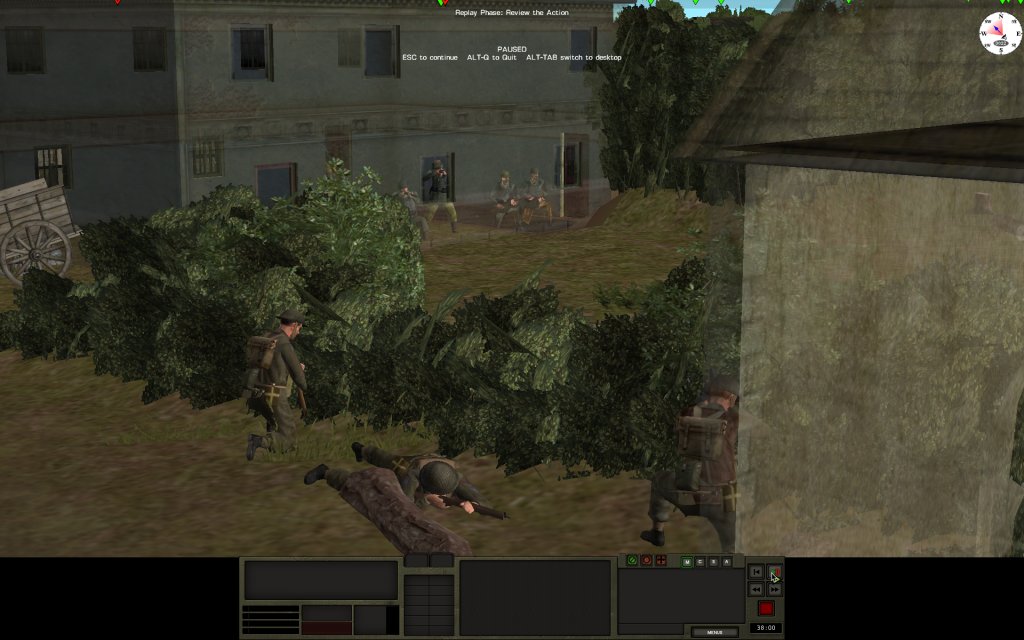
One of the occupants is hit and the remainder break and run
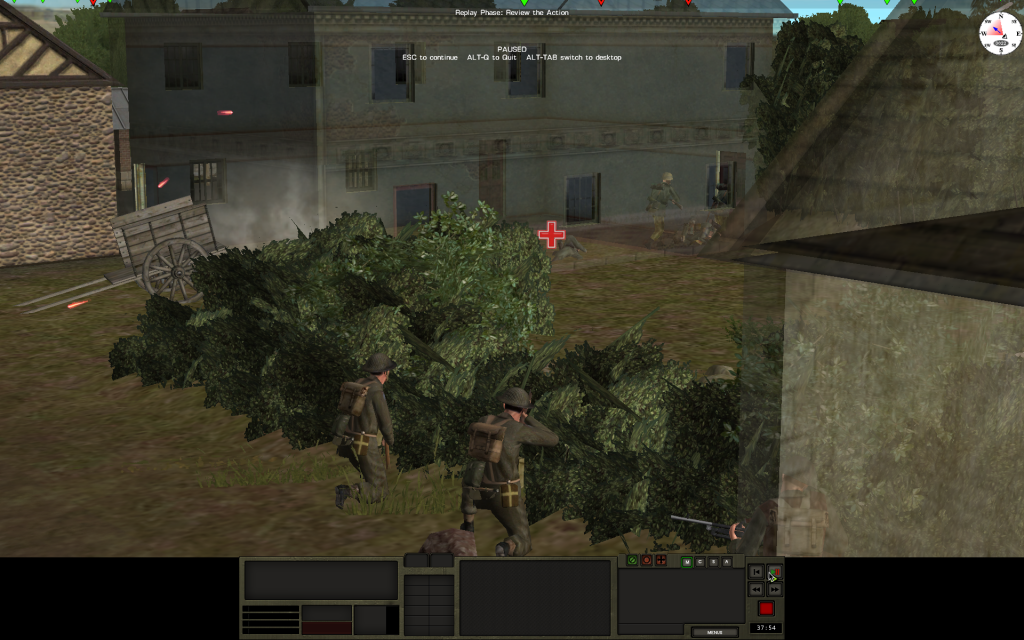
3 men try to escape down the road, but that is covered by 9 Platoon, D Coy. 2 are cut down and the third surrenders
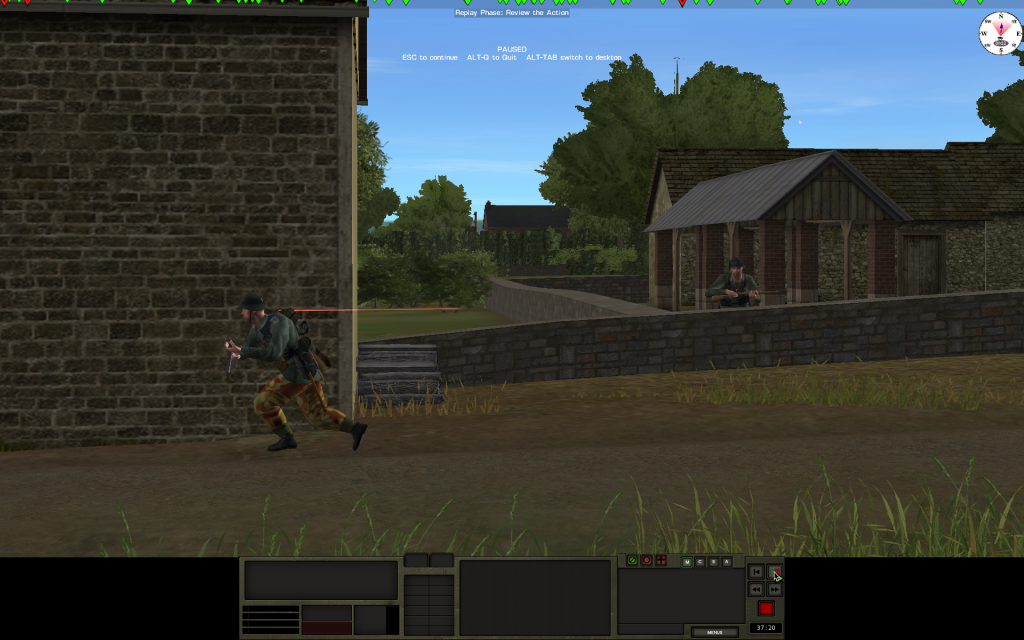
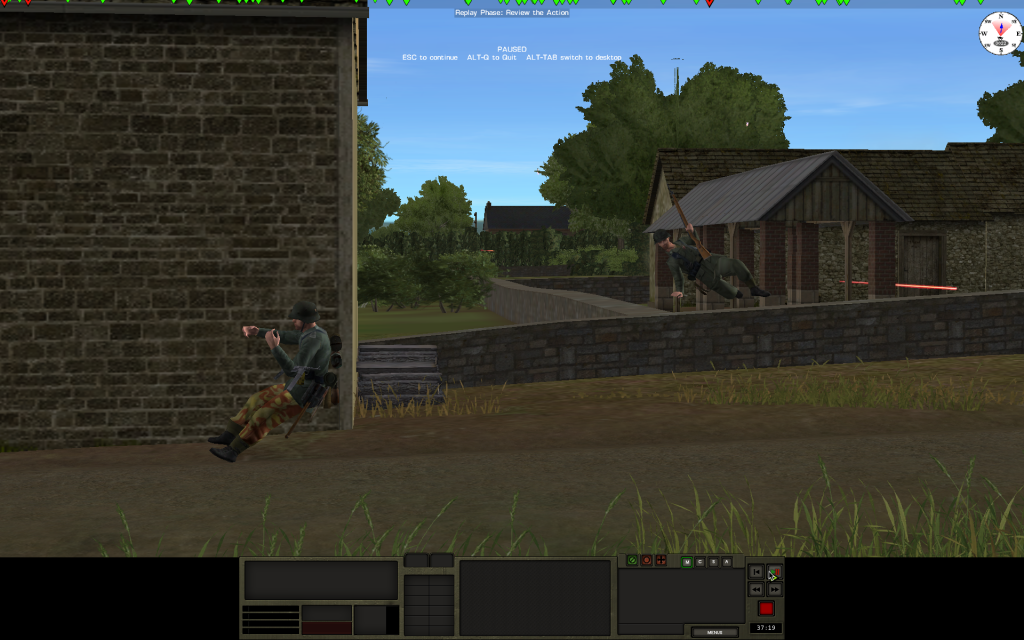
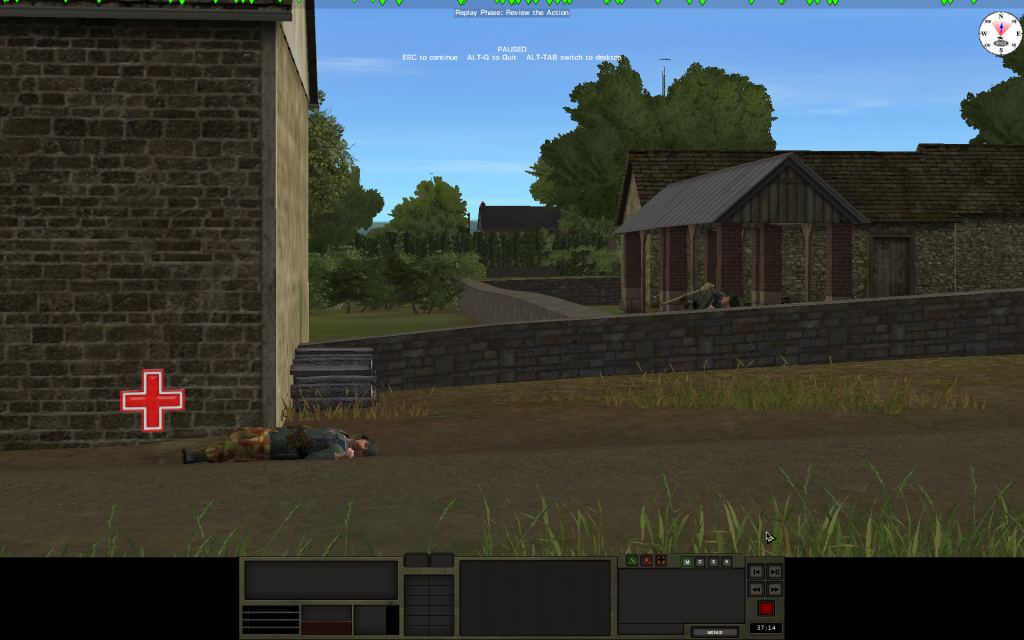
-
Aah that would explain it.
Its not really the timing - I just wanted them to get my money early, to help their cash flow...

-
"a quarter of the regiment's loss during the whole war"
Definition of "outlier".
Yes there are occasions in which a whole battalion was destroyed in a day's fighting. There are occasions on the Russian front where a whole regiment was destroyed in a day's fighting, and plenty in which a Russian rifle division was destroyed in 2-3 days. But this did not happen *every time*, and in CM today, it does.
Casualties are higher in CM than in the real combat it depicts. All the cherry picking in the world can't change that fact.
Well I do not think that we are fundamentally disagreeing with each other - what I think you might consider is that most of the battles that we fight in CM are all probably outliers because they normally represent the most intense engagements in the campaign.
Most (but not all) CM scenarios do not represent the 95% of the engagements / days that occurred in the real campaign involving less intense fighting. I suppose that is probably because a CM scenario involving a historical battalion advance of 1 km over a day in which 25-30 casualties are suffered is going to be less interesting in gaming terms than the much more intense, but much less typical engagements represented by most scenarios.
I don't think therefore that I am cherry-picking - rather we choose to cherry pick the battles we fight in CM. From an academic view point we need to recognise that when we fight these engagements in CM, we should not view them as being the normal day for the units concerned - rather they may represent, for the unit concerned, the single most intense day of the whole campaign.
Having said that I do think that the game might be made more historically accurate if the units we command were, on occasion, more willing to refuse to do what we order, or even do something completely different (like begin to drift to the rear) particularly if they have taken casualties.
-
When I select delivery options I am only offered digital download and mail. I only want digital. Any ideas?
-
I don't agree with the suggestion that the casualty rates suffered in CM battles are necessarily unrealistic compared to the rates suffered in real life in Normandy or that battalions did not suffer more than 50 casualties in one day. On the allied side, most days most battalions may have suffered very limited casualties or not have suffered any casualties at all. However battalions engaged in big set piece battles often suffered very badly on one single day.
As a first point, I think most people are broadly aware that the CM games compress time, so that several hour / day long engagements are played over 1-2 hours of game time. The reason for this is that we don't want to spend 6 months fighting a 6-8 hour game. To do this the game basically loses those parts of a real life battle where soldiers were hunkered down behind a wall or in a ditch for 2 hours without doing anything and waiting to be told what to do or for something to happen.
So a battalion engagement where each side suffers 150 or so casualties in a 1 hour 30 minute game is really a reflection of a fight perhaps lasting 1/2 a day or a whole day.
In the British- Canadian - Polish sector of the beachhead battalions routinely suffered catastrophic casualties in day long engagements. Examples include 7 Royal Hants' attack on Maltot, supported by 4 Dorsets on 10 July and 5 DLCI's fight for Cornwall wood on Hill 112 on the night of 10 July and into 11 July.
British infantry battalions had a TOE of 845 men including HQ elements and support company. Rifle companies had a strength of 122 men.
In Operation Jupiter the 43rd Division appeared to operate a practice of having about 10% of their rifle companies' manpower "left out of battle" as a cadre to reform the battalions in anticipation of catastrophic losses. Accordingly these battalions may have operated 110 man companies or withheld one company each from the engagements. On that basis the rifle strength for each battalion may have been between 360-440 men for the fighting on 10 July, with additional manpower from carrier platoons and HQ elements.
7 Hants' attack on Maltot resulted in 18 officers and 208 other ranks becoming casualties in less than a day. 9th Royal Tank Regiment supported 7 Hants' attack on Maltot and lost 16 tanks during the day and 65 casualties (a quarter of the regiment's loss during the whole war).
5 DCLI's attack on and subsequent defence of Cornwall wood on Hill 112, which lasted a night and a day ended with 75 survivors retreating back to their start lines, with about 320 casualties, including the CO. 7th Royal Tank Regiment supported 5 DCLI's attack on Cornwall wood and suffered similarly, its CO also killed.
I haven't found the casualties for 4 Dorsets but they suffered badly also.
Overall 43rd Division suffered 2,000 casualties in a day and a half. 4th Somerset Light Infantry received 470 replacements the day after Jupiter ended to reform the battalion.
German casualties were also very heavy, particularly in the 9SS PzGr companies counterattacking 5 DCLI over open ground and in the face of the corps and divisional artillery used by the British. One of these companies had 5-6 men left at the end of the battle.
These casualties for a day long engagement were, on occasion, matched by Canadian battalions fighting for the villages around Caen and in Carpiquet.
I recognise that the situation in the American sector was very different - the fighting to expand the beachhead until Cobra was not characterised so much by big set pieces like Epsom and Jupiter. Rather the fighting was characterised by a continuous daily advance through difficult bocage country where the advancing battalions were continually losing men at a steady rate day in day out. In that respect the lower daily average losses quoted earlier in this thread may have rather more relevance.
-
Turn 21 completed
the Stuarts north of Buron come under fire from a schreck team. fortunately these guys don't seem to have had much practice and the shot goes sailing way over ahead. You can just see the rocket in the top part of the screenshot
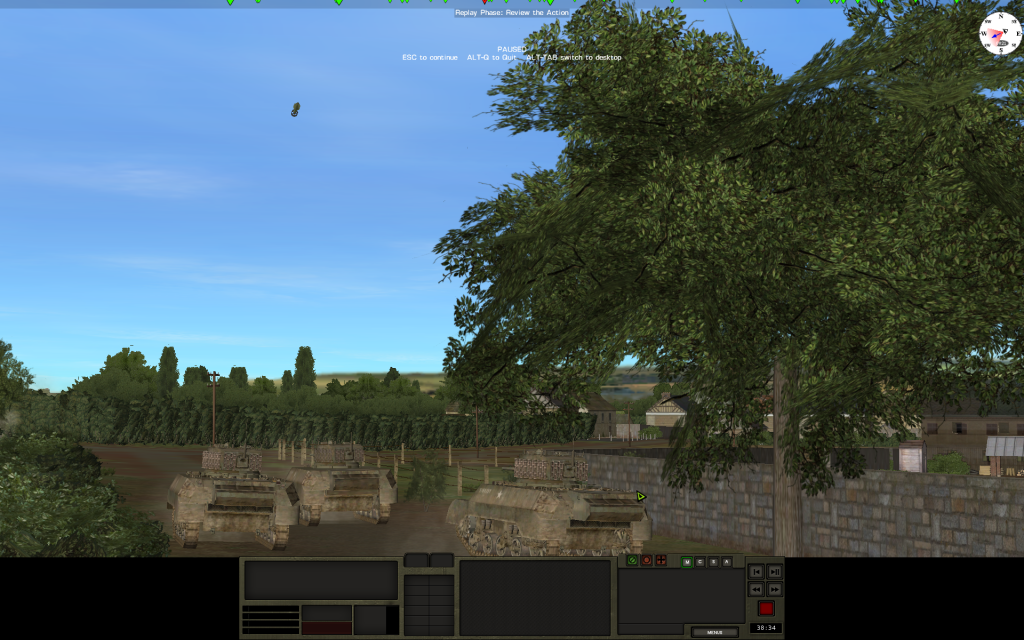
The maker's serial number 4322!
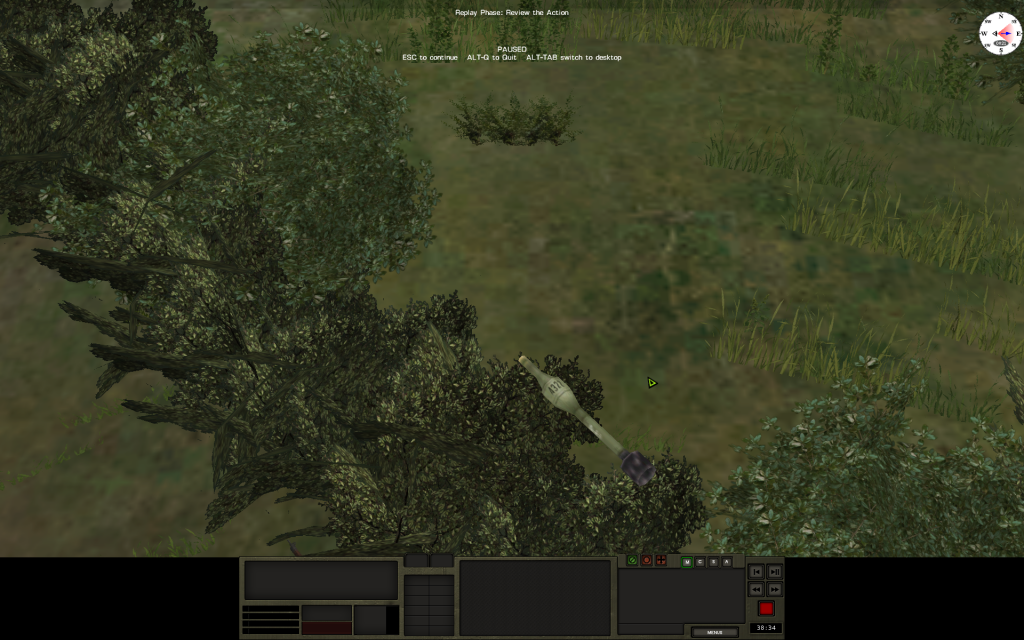
-
Turn 21 completed
The Germans in the trenches do not fare so well. First a rifleman gets hit by mg fire
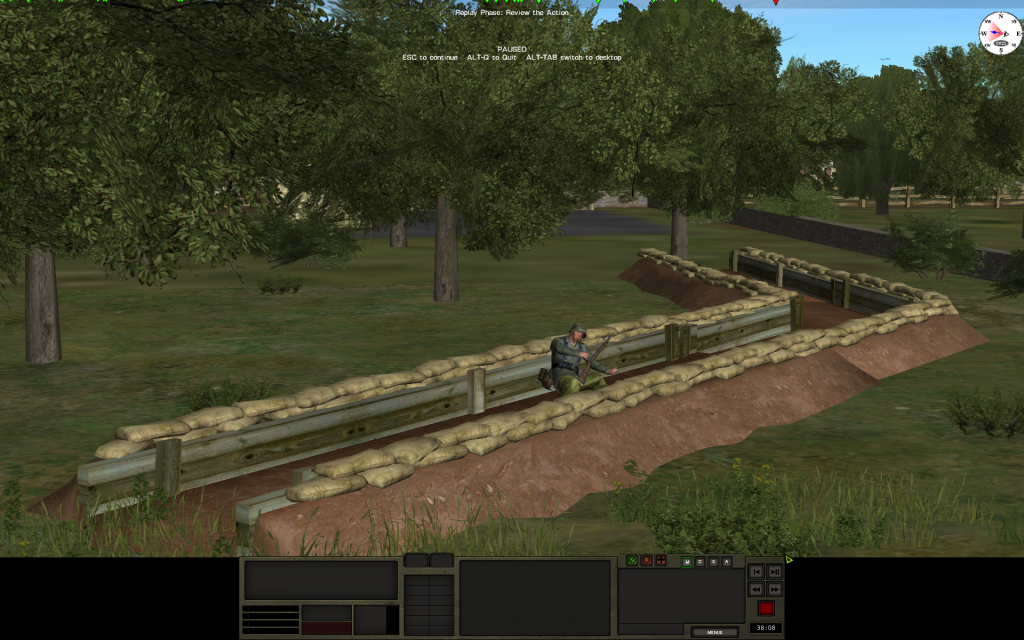
and shortly after an mg gunner gets hit by a mortar round

I have to say that these guys are certainly holding up well in the face of some quite intense fire, and I take two casualties myself this turn.
-
Turn 21 completed
One of the German teams that did the damage to 10 platoon last turn runs through flanking fire from one of the stuarts to the north, and miraculously all three escape unscathed grrr!

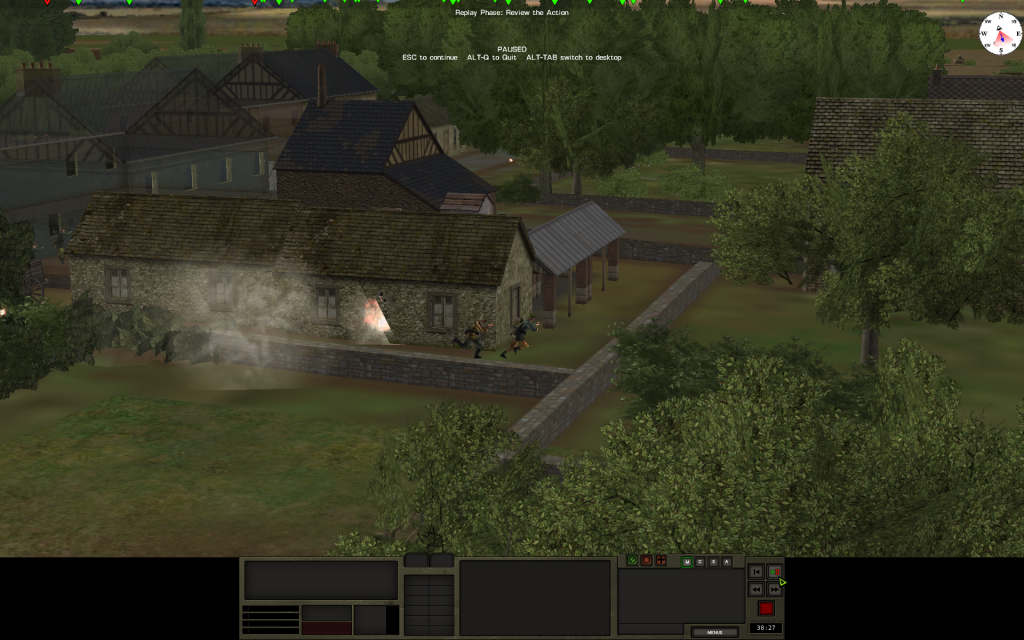
-
Turn 21 completed
Elements of 9 and 10 platoons move to bring the Germans under fire from various directions. The Germans are located in the green house.
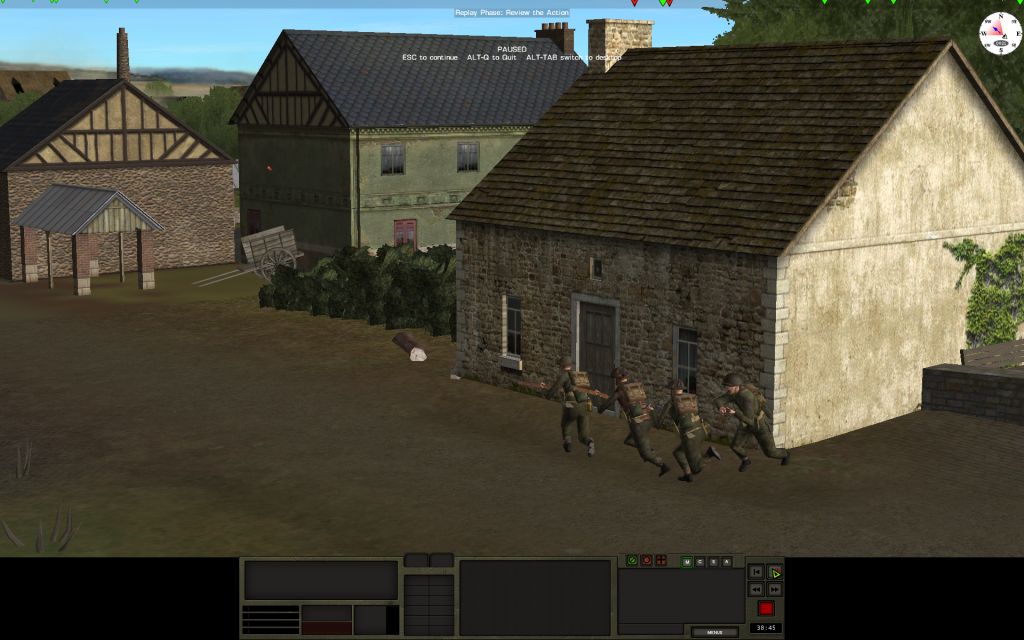
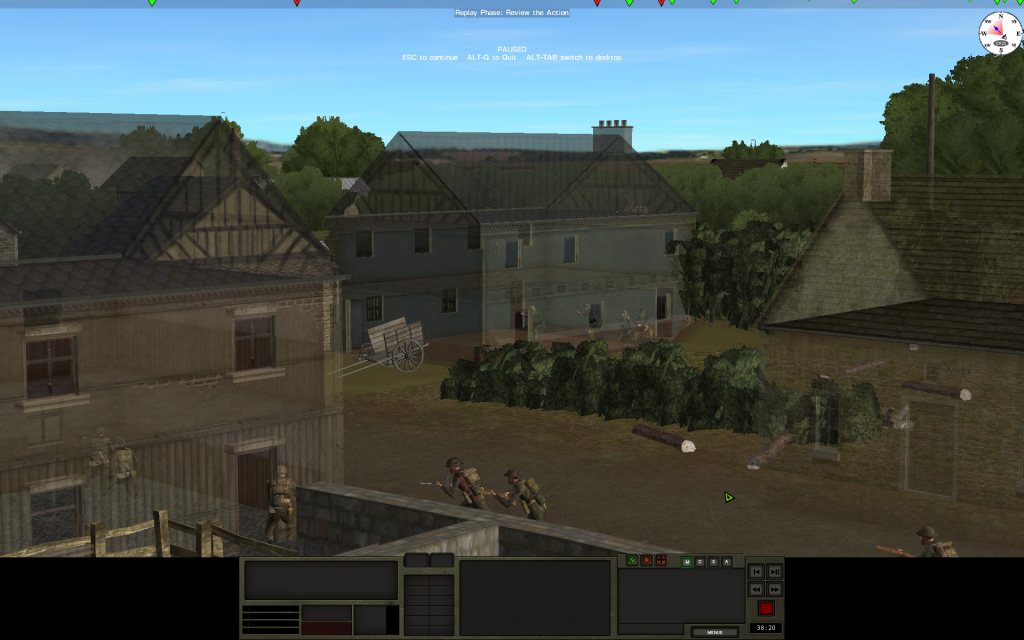
A stuart moves up to batter the house from the south
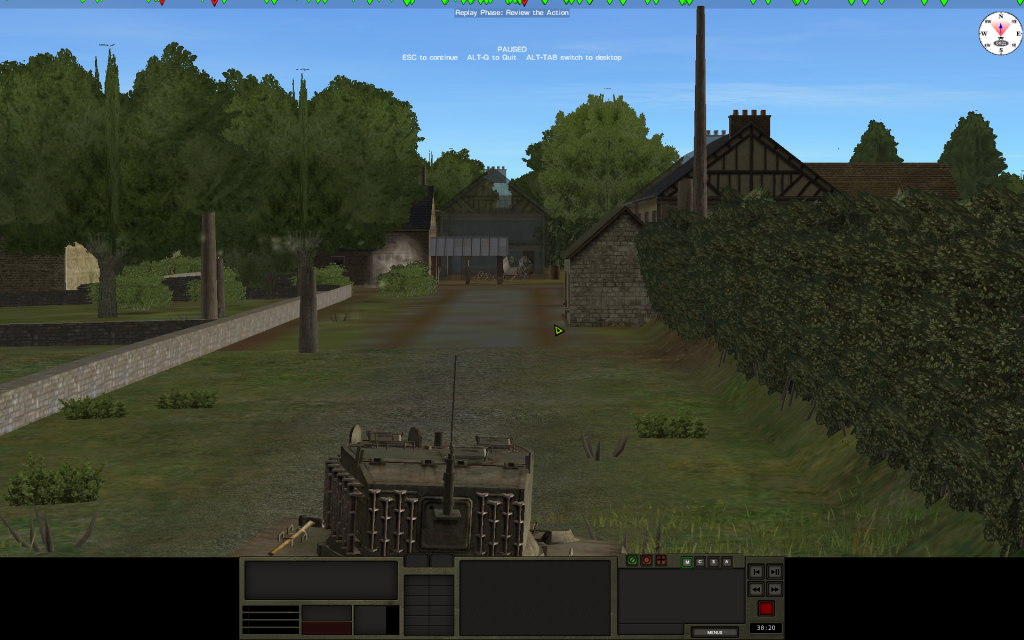
-
Are you sure about that? I'm fairly sure the data set is measured in dozens of battles, not hundreds.
I was referring at the later Capture Rate study, which looked about 180 divisional engagement. I suppose calling that 'hundreds' though might be a slight exaggeration
-
There's no way the Axis will escape this battle, so I will be able to demonstrate how to remove a captured, or destroyed enemy PzC unit after a CM battle. I will also write up some rules regarding what happens ifv an enemy force is encircled on the CM map.
Of course, there was no way they could escape my cunning plan, ah ha ha ha etc

-
I was looking into making a map of Hill 112 and was searching the internet for topographical maps when I came across this iPhone app:
You can download it for free and register - you can then view a 1:25,000 topographical map of france with 5m elevations on your smartphone or tablet. You don't need to buy the map (you can do that if you want - the purpose of the app is to enable people to buy and download specific maps on to their phone for walking etc when they don't have access to wifi / 3G)
Viewing this on a smartphone alone is not great (I haven't tried it on an iPad yet) but it's quite useful if you need instant access to a topographical map and don't have a paper one to hand.
Anyway, I can look at the detailed elevations of Hill 112 which I couldn't before.
Since I am making this post, is anyone aware of a Hill 112 map? - I don't want to repeat someone else's efforts if one has been produced already
-
JasonC-You did a nice job in summerizing Dupuy. I checked the book out of the library a while ago, so I don't remember exactly how he evaluated battle "success", so I will defer to you on that point.
With regards to his methodology, what Dupuy is doing is basically what a lot of scientists and operational research guys do, create models based on empirical data and then test them. My lab is uses a similar modeling approach to develop a diagnostic test to identify people with kidney cancer. The problem with all models is one of "over fitting", where you assess the validity of the model only using the data you used to make it in the first place. The interesting thing about Dupuy's model is that the model has been tested on separate valadation data sets that were not used to make the model in the first place. It looks like the model is right about 80-85% of the time.
Now if I put on my criticism hat, I will point out that if one flips a coin, one will guess the outcome of a binary event (like a battle) 50% of the time, so saying that a model is right 80% of the time is good, but not great.
Micky D-I've got to read that book!
That's always the problem with forecasting models though, isn't it. It seems to me that a model that is 80-85% correct in respect of a subject which probably has as many variables as global weather systems is pretty impressive
-
That's all fine, plugging numbers into an equation, but there doesn't appear to be anything in those equations that account for most of the real world factors that affected the German army in 1944. He is also, by default, cherry picking engagements to make his calculations since he isn't selecting every division sized engagement. It's a data set, but it isn't very persuasive to me since I'm well read enough to know about the substantial problems faced by the German Army in 1944. Which battles during the Battle of the Bulge did he select? The ones involving the 101st Airborne at Bastogne or the ones involving the green American forces in the St Vith area?
I don't believe Dupuy does this - the studies made by the Dupuy institute looked at hundreds of engagements in Italy, the Ardennes and Kursk for example. Individual divisions are given individual CEVs. His studies recognise very wide qualitative differences between different divisions in the same army - particular the German army for obvious reasons.



CMPzC Normandy '44 Caen Operation - Allied HQ
in Combat Mission Battle for Normandy
Posted
Turn 23 completed
Some screenshots from the last as the German defenders retreat from their trenches and the green house
This last guy could be in trouble next turn, as he is turning into the line of fire of a couple of 9 Platoon's sections